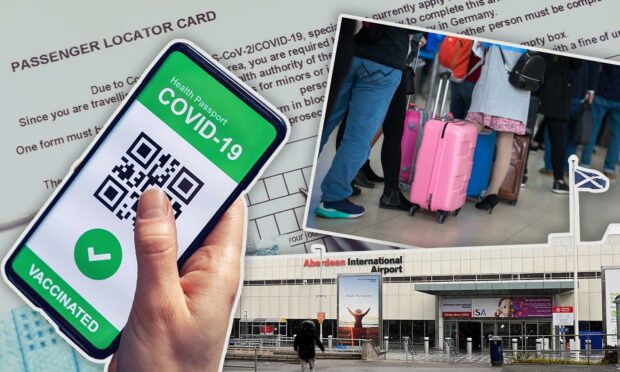It seems like every other day the guidance for international travel in and out of the UK changes.
If you’re a fan of checklists, you won’t break a sweat when the time comes to book your next holiday.
PLC? LFT? PCR? There are many abbreviations for crucial documents and proof needed when crossing international waters.
Some airlines have warned passengers of lengthier check-in times, and long queues can be expected as everyone goes through the new process of having their passenger locator forms and vaccine certificates verified.
After speaking to Aberdeen International Airport’s operations director, Mark Beveridge, he broke down some key tips to help have a stress-free check-in experience.
These include:
- Have a physical and digital copy of your vaccine certificate on hand.
- A completed Passenger Locator Form.
- Understand the timeframe validity of the Covid test for your destination.
- Look for longer transfer windows at hub airports.
What should I have on hand at the check-in desk?
Current guidelines to enter the UK from abroad requires passengers to have proof of being fully vaccinated, your Day 2 Covid test booked and a completed Passenger Locator Form.
Mr Beveridge said the best advice he can offer jet setters is to take the time to go through the website of the country you’re travelling to for details.
Airlines will relay this information to the ground handlers, those behind the check-in counters, and passengers are expected to meet the requirements.
“The ground handler is the gatekeeper effectively,” he added.
“So, when you arrive at the check-in desk they are looking for you to meet all the requirements.
“We’d say to any passenger coming forward: carry your vaccination certificate, digitally and probably a paper copy is always good for reference.
“Make sure you have completed any passenger locator forms for the country you’re entering.”
Not one set of rules for all countries
The operations director emphasised the importance of understanding the testing requirements and nuances.
“Some countries do it on the basis of when you start your journey— and it could be 72 hours before that. Others say when it’s from the point of entry,” he added.
“There’s not one set of rules for all.
“But, I think if people go with that mindset of: we need to make sure that we’ve got all our paperwork in order from the UK side, and we’ve done as much to prepare for the country we’re entering. You should be in a good position.”
And if you’re usually a stressed-out traveller…
Mr Beveridge said his main tip to people is to try and enjoy it.
“For a lot of people, it’s going back for the first time and to actually travel after a number of years. Enjoy it,” he continued.
“Give yourself plenty of time. Be as prepared as you can be. And really just listen to people. Engage where you need to actually listen to people.
“The staff are there to try and make your journey as pleasant as possible.”
‘Things were changing on the hoof’
Mr Beveridge said everyone’s experience of travelling during the pandemic has varied.
It depends on your destination and where we are “in the cycle of change”, such as restrictions and guidelines updating depending on the virus’ climate.
Recently, he travelled with his family to Tenerife before Christmas and described his own experience.
“Just prior to leaving, [the guidelines] changed from a day two lateral four test, to a day two PCR,” he said.
“Also the requirement to test prior to re-entering the country changed.
“So, there was an element of things were changing on the hoof for me as we were travelling.
“There’s a few things that pose challenges and take a little bit more time than you expect.
“And other things that actually go better than you expect.
“I didn’t feel it was overly onerous. The benefits of being away and getting some sunshine was great.”
‘It took four airports and almost eight tests’
Our reporter Ana Da Silva recently travelled home before the holiday period and told us of her experience.
Confession: I’m not a planner.
I have never been a planner. And as much as I would like to be one of those checklist types, it’s always felt a bit like having a tiny rock in my shoe.
It doesn’t feel natural, and it stresses me out while I go about my day.
But like many, the last two years have taught me to adapt – and when it came time to travel, I had to become a planner.
It took four airports, and roughly eight tests (which did not come cheap), to head back home and see my family after more than two years.
What I hadn’t anticipated was how much time check-in would take, and the amount of paperwork that needed to be done before showing up at the airport.
Gone were the days of checking in online and heading straight to security if you only had carry-on luggage.
I realised, and not only at Aberdeen Airport, that the queues were longer because many fellow travellers hadn’t completed the passenger locator forms for their destination.
The ground staff were patiently helping to fill them out or assisting travellers to correct any errors.
It also seemed like they were left to play the role of tech support, teaching an older lady in the queue ahead of me how to download the vaccine app on her mobile.
Another circumstance I hadn’t anticipated was the delays, and how they would affect any Antigen or PCR test I took.
With labs closing around 3pm or 4pm back home, I tried to get an appointment as late as possible with my flight the following day at 2pm. This would cover me for nearly 24 hours before boarding.
However, and just my luck, it was delayed until 3pm and groundstaff said we were cutting it close.
Thankfully, I managed to get through the window of time my Antigen would still be valid for departure.
It’s a stressful experience, not one I’m very keen to repeat any time soon. However, I understand protocols must be put in place to stay safe – especially when travelling overseas.
As stressful as I might find it, I can only take Mr Beveridge’s advice and try to enjoy it.
The chance to reunite with loved ones after so long outweighs the stress of planning.
More health news…
Aberdeenshire mum says 8,000 mile Mexico trip is ‘only option’ for her incurable condition
North-east residents left waiting double the target time for ambulance

